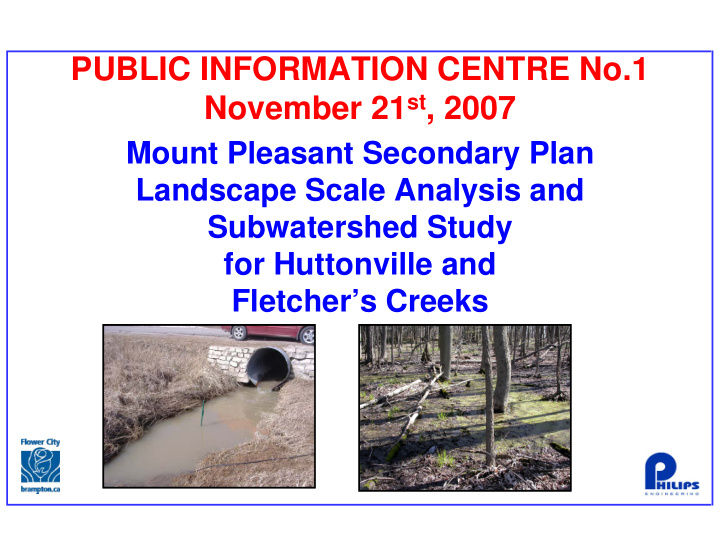



PUBLIC INFORMATION CENTRE No.1 November 21 st , 2007 Mount Pleasant Secondary Plan Landscape Scale Analysis and Subwatershed Study for Huttonville and Fletcher’s Creeks
Background Information • The City of Brampton completed the “North West Brampton, Environmental Open Space Study” in March 2005 for the North West Expansion Area. That study was part of the assessment to determine the long-term development potential for North West Brampton and to determine whether it would be appropriate to expand the City’s urban boundary. • The Open Space Study was a one of five component studies intended to fulfill the technical requirements for a Regional Official Plan Amendment. • As part of the Open Space Study, Terms of Reference were developed for further detailed environmental studies required to support Secondary Planning. • Concurrently, the CVC worked consultatively with the City of Brampton, Region of Peel, MNR, and Landowner Representatives to develop formal Terms of Reference for the Landscape Scale Analysis (LSA) and the Subwatershed Studies for Huttonville and Fletcher’s Creek.
Subwatershed Planning Process • Summary of City Initiatives (i.e. initial thought on community planning, transportation and public • What information do we already have? works, etc.) • What are the information gaps ? • Initial development of NHS • What are the resources? framework and sustainable • What are the functions & linkages between management practices • Provide Subwatershed and LSA environmental resources? Phase 1 • What are the needs of City initiatives (i.e. findings to city initiatives Subwatershed • Public Meetings transportation studies, etc.? Characterization • What are the goals for the subwatershed? • Summary of City Initiatives Credit River Water • Refinement of NHS priorities (in Management • What are the stressors? relation to LSA) and sustainable Strategy • How will impacts be evaluated? management practices Phase 2 • Provide Subwatershed and LSA identifies: • What are the impacts from the stressors? Impact • Sources of findings to city initiatives • What is the status of City initiatives? Assessment • Public Meeting contamination • What are pros and cons of all solutions • Key issues • What is the preferred solution & the criteria for • Summary of City Initiatives LSA • Goals selection? • Final NHS with restoration • Preliminary mitigative opportunities, priorities (in relation to measures • Who will be responsible for addressing the Phase 3 LSA) and sustainable management • Water Resource recommendations? practices Management targets • What is the status of City initiatives? • Provide Subwatershed and LSA Strategies and • Resource constraints Implementation findings to city initiatives • Have goals been met? • Public Meeting • Develop monitoring program that • Are the original assumptions appropriate? addresses measurable subwatershed Phase 4 • Should parts of the plan be modified when goals Long-term more information is available? • Develop an Adaptive Environmental monitoring • What is the status of City initiatives (i.e. Management program (AEM) to transportation studies, etc.) ? evaluate assumptions, • How do you integrate science, management and recommendations public needs? • Public Meeting • Develop protocol to identify triggers for updating the Subwatershed Study and Landscape Scale Analysis North West Brampton
Integrated Land Use Planning Process
Study Area – Arial (See Display Board) North West Brampton
North West Brampton
Municipal Class EA Process • Many projects related to municipal systems are similar in nature , are carried out routinely , and have predictable and mitigable environmental effects which are investigated according to the Municipal Engineers Association "Municipal Class Environmental Assessment,” (June 2000) document. • Municipal Class Environmental Assessment (Class EA) process categorizes proposed municipal projects according to their anticipated environmental impact, and calls for increasingly stringent review requirements as the magnitude of the anticipated environmental impact increases. • The Class EA defines a Master Plan as: “A Long Range Plan, integrating infrastructure requirements for present and future land use with environmental planning principles. The Plan examines the whole infrastructure system in order to outline a framework for planning subsequent projects and/or developments (Class EA, 2000).” • The Subwatershed Plans being prepared for North West Brampton constitute environmental management Master Plans. North West Brampton
Municipal Class EA Process Phase 3 Phase 1 Phase 2 Alternative Design Phase 4 Phase 5 Identify Alternative Concepts Environmental and Describe Planning Implementation For the Preferred Study Report the Problem(s) Solutions Solution • Identify reasonable • Identify alternative • Compile an • Proceed to construction alternative planning designs to implement Environmental Study of the project. solutions. the preferred solution. Report (ESR). • Monitor environmental • Evaluate the alternative • Inventory natural, • Place ESR on public provisions and solutions, taking into social/cultural and record for review for 30 commitments. consideration economic days. environmental and environments. • Notify the public and technical factors. • Identify the impact of government agencies of • Identify a preferred the alternative designs completion of the ESR solution to the after mitigation. and of the Part II Order provision in the EA Act. problem(s). • Evaluate alternative designs. • Identify a preferred design. Agency and Agency and Stakeholder Stakeholder Consultation Consultation Problem Statement Preferred Solution Preferred Design ESR North West Brampton
Credit River Water Management Strategy Adaptive Water Quality Environmental Water Budget Flow Other: Management • NHS Management Study Management Study • Fisheries Strategy Study Provide direction to local municipalities on land use, environmental and stormwater management implementation
Recommend
More recommend